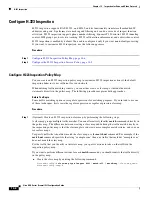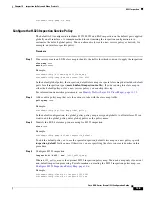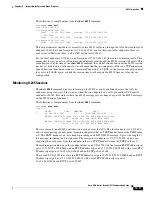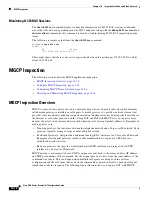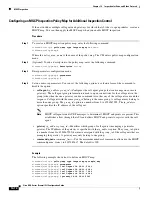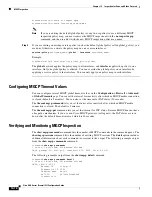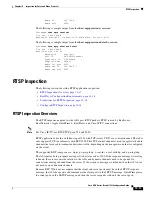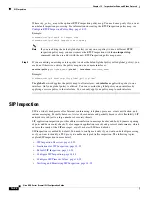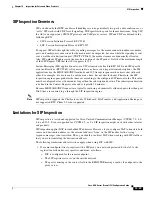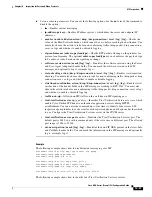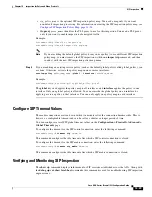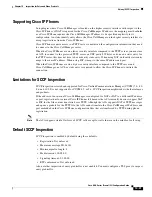
14-19
Cisco ASA Series Firewall CLI Configuration Guide
Chapter 14 Inspection for Voice and Video Protocols
RTSP Inspection
Configure RTSP Inspection Policy Map
You can create an RTSP inspection policy map to customize RTSP inspection actions if the default
inspection behavior is not sufficient for your network.
When defining traffic matching criteria, you can either create a class map or include the match
statements directly in the policy map. The following procedure explains both approaches.
Before You Begin
Some traffic matching options use regular expressions for matching purposes. If you intend to use one
of those techniques, first create the regular expression or regular expression class map.
Procedure
Step 1
(Optional) Create an RTSP inspection class map by performing the following steps.
A class map groups multiple traffic matches.You can alternatively identify
match
commands directly in
the policy map. The difference between creating a class map and defining the traffic match directly in
the inspection policy map is that the class map lets you create more complex match criteria, and you can
reuse class maps.
To specify traffic that should not match the class map, use the
match not
command. For example, if the
match not
command specifies the string “example.com,” then any traffic that includes “example.com”
does not match the class map.
For the traffic that you identify in this class map, you specify actions to take on the traffic in the
inspection policy map.
If you want to perform different actions for each
match
command, you should identify the traffic directly
in the policy map.
a.
Create the class map by entering the following command:
hostname(config)#
class-map type
inspect
rtsp
[
match-all | match-any
]
class_map_name
hostname(config-cmap)#
Where
class_map_name
is the name of the class map. The
match-all
keyword is the default, and
specifies that traffic must match all criteria to match the class map. The
match-any
keyword
specifies that the traffic matches the class map if it matches at least one of the criteria. The CLI
enters class-map configuration mode, where you can enter one or more
match
commands.
b.
(Optional) To add a description to the class map, enter the following command:
hostname(config-cmap)#
description
string
c.
Specify the traffic on which you want to perform actions using one of the following
match
commands. If you use a
match not
command, then any traffic that does not match the criterion in
the
match not
command has the action applied.
•
match
[
not
]
request-method
method
—Matches an RTSP request method. The methods are:
announce, describe, get_parameter, options, pause, play, record, redirect, setup, set_parameter,
teardown.
•
match
[
not
]
url-filter regex
{
regex_name
|
class
class_name
}—Matches the URL against the
specified regular expression or regular expression class.
Step 2
To create an RTSP inspection policy map, enter the following command:
hostname(config)#
policy-map type inspect rtsp
policy_map_name
hostname(config-pmap)#
Содержание ASA 5508-X
Страница 11: ...P A R T 1 Access Control ...
Страница 12: ......
Страница 60: ...4 14 Cisco ASA Series Firewall CLI Configuration Guide Chapter 4 Access Rules History for Access Rules ...
Страница 157: ...P A R T 2 Network Address Translation ...
Страница 158: ......
Страница 204: ...9 46 Cisco ASA Series Firewall CLI Configuration Guide Chapter 9 Network Address Translation NAT History for NAT ...
Страница 232: ...10 28 Cisco ASA Series Firewall CLI Configuration Guide Chapter 10 NAT Examples and Reference DNS and NAT ...
Страница 233: ...P A R T 3 Service Policies and Application Inspection ...
Страница 234: ......
Страница 379: ...P A R T 4 Connection Management and Threat Detection ...
Страница 380: ......
Страница 400: ...16 20 Cisco ASA Series Firewall CLI Configuration Guide Chapter 16 Connection Settings History for Connection Settings ...
Страница 414: ...17 14 Cisco ASA Series Firewall CLI Configuration Guide Chapter 17 Quality of Service History for QoS ...


